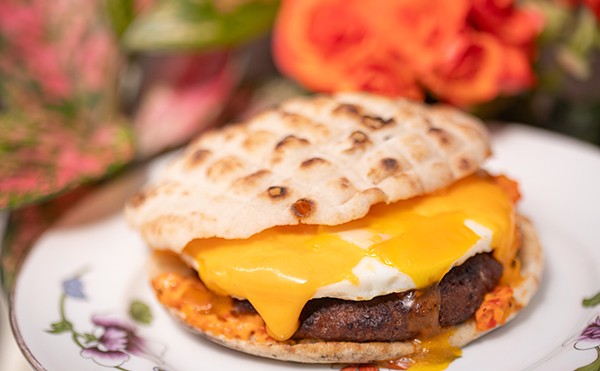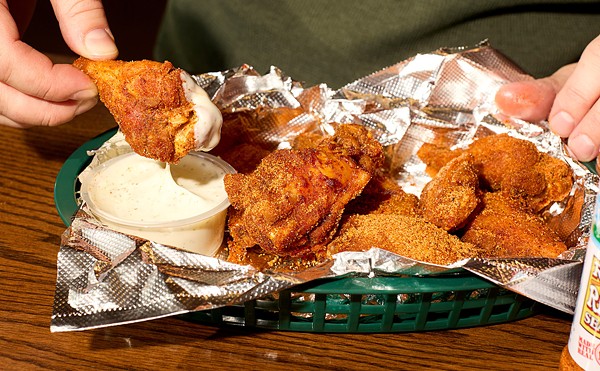The Second Empire style, which features tall, narrow windows, is well suited to row houses, and the new Park Avenue Bistro stands shoulder-to-shoulder with other dwellings that have been converted to businesses. The restaurant's compact, ear-rattling dining room has lofty ceilings and brick, stucco and plaster walls hung with sleek black-and-white photographs and contemporary color prints. The women's restroom is just a few yards from the tables and accommodates only one person at a time, so a woman who finds it occupied must either retreat to her table and try again later or stand awkwardly in the dining room to await her turn.
Behind the building, a stockade-fenced patio features a tranquil lily pond and an unruly fringe of greenery twinkling with a string of white lights. The tiki torches used to illuminate the tables weren't working the evening we sat outside, so we held candles above our menus, straining to see the single page of selections. Chef Erick Brown's American-bistro menu is balanced among fish, chicken, pork, beef, veal and pasta dishes, including a lone vegetarian entrée. Two or three specials are offered each evening to supplement the menu.
The entrées are reasonably priced, topping out at about $20. Most of the appetizers and all three side dishes, however, are preposterously expensive, with two small crab cakes going for about a 10-spot. The bruschetta of the day, topped with simple ingredients like tomatoes and basil, will set you back almost 7 bucks, and you'll shell out $3.50 for a scoop of mashed potatoes. Many diners who live west of the city are willing to drive past popular restaurant districts like Clayton and the Central West End to find a good value, but the Park Avenue Bistro gives them little incentive to go out of their way.
Those costly crab cakes, which are the size, shape and color of small biscuits, are made with canned white crab meat. Owner Dana Ruben prefers not to disclose the recipe's other ingredients. The golden patties are set askew on a dainty asparagus salad, and the plate is daubed with coarse mustard sauce. Another seafood appetizer, a heaping bowl of steamed mussels, earns its price tag, The shellfish are steeped in a tomato-basil broth and topped with tomato concassé (peeled, cored, seeded and chopped fresh tomatoes) and a chiffonade of fresh basil (basil leaves loosely stacked, rolled into cigarlike cylinders and cut crosswise into ribbons).
A clever starter billed as "portobello 'carpaccio'" consists of a portobello mushroom cap cut into thin slices that are fanned out and drizzled with Dijon-spiked crème fraîche (thickened, lightly fermented cream). The dish is playfully named after the Italian dish of raw beef shaved into thin, meltingly tender strips. The mushroom slices are presented on a bed of wilted arugula (leafy greens, sometimes called "rocket," that taste similar to horseradish) and showered with brittle shards of Parmesan curled gently like wood chips. The bistro's smoked-salmon appetizer is a straightforward yet carefully conceived dish: Four coral rosettes of the fish are placed around a salad of vertically sliced sashes of zucchini, carrots and celery root (a starchy tuber also called "celeriac"). The plate is then dotted with capers, strewn with julienned red onion and finished with a splash of tart vinaigrette.
Having sampled the smoked salmon and the steamed mussels, we were eager to try more seafood. One evening, Brown offered a special of blue marlin. Sometimes called a "sailfish," the marlin is a type of billfish, part of the swordfish family. Its flesh is paler and less dense than that of tuna, a similar fish. The wedge of marlin Brown prepared was pale ivory, with an attractive lattice pattern imprinted by the grill. The mild, almost neutral flavor of the fish was lifted with a sweet celery-root purée, baby shrimp and julienned tomatoes. An inky spoonful of olive tapenade mimicked a dab of caviar, but its piquancy was perhaps too overbearing for this meek fish. The plate was rounded out with a few green beans and carrot coins. In fact, this wearisome combination of vegetables was used to garnish every entrée we sampled.
Pecan-crusted Missouri rainbow trout, listed on the regular menu, is halved and splayed out, the tail curved up stiffly as though the fish were still locked in its death throes. To prepare the dish, Brown dusts the trout with finely ground nuts and then fries it, leaving the oily skin crisp and flavorful. However, the fish is then unaccountably blanketed with a delicate beurre blanc sauce (a French sauce of cream, butter, shallots and white wine), making the coating as soggy as an unfinished bowl of cornflakes.
The steak entrée we ordered did not make the pulse pound. The kidney-shaped filet of beef, which we requested be cooked medium, arrived uniformly gray, with no trace of pink in the center. The filet (more correctly spelled "fillet"), also known as the tenderloin or undercut, is the long muscle that runs beneath the animal's spine near the sirloin. The cut, or "joint," should be lean, tender and savory, but ours was fibrous and flat-footed. Brown tops the steak with tomato concassé and an herbed goat cheese freshened with mint, a flavor that revs up the tangy, aged cheese.
The bistro's spare menu has no dessert section. Edy's ice cream and sorbet are sometimes available, and most other sweets come from Marty's Baking, a marvelous confectionery near Soulard. On some nights Ruben makes one or two desserts, such as a juicy, homey peach-blueberry crisp. She'd like to eventually make all the desserts herself.
One appalling discovery was that the restaurant uses canned whipped topping in place of real whipped cream. If you think this is an innocuous substitution, try them side-by-side. Whipped cream is a snap to prepare with the whisk attachment of a stand mixer, and most chefs would no sooner squirt canned whipped topping on their desserts than they'd mix Spam into their pâtés or pour Cheez Whiz over their asparagus. The restaurant takes other shortcuts, too. For example, our server brought us a flaccid triangle of butter on a smudged glass plate that had clearly been used by other diners. And when we told the waiter that our glasses of Sangiovese tasted acrid, as though the wine had oxidized, he admitted that the bottle had been opened the day before. With missteps like these, in addition to steep prices, a lean menu and dishes that are competently prepared but rather ordinary, the Park Avenue Bistro is unlikely to draw many new faces to this grand old city neighborhood.





